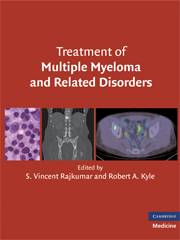Book contents
- Frontmatter
- Contents
- List of Contributors
- 1 DIAGNOSIS AND GENETIC CLASSIFICATION OF MULTIPLE MYELOMA
- 2 STAGING AND RISK-STRATIFICATION OF MULTIPLE MYELOMA
- 3 TREATMENT OF NEWLY DIAGNOSED MULTIPLE MYELOMA
- 4 MAINTENANCE THERAPY IN MULTIPLE MYELOMA
- 5 TREATMENT OF RELAPSED AND RELAPSED/REFRACTORY MULTIPLE MYELOMA
- 6 DIAGNOSIS AND TREATMENT OF MYELOMA BONE DISEASE
- 7 TREATMENT OF MYELOMA-RELATED COMPLICATIONS
- 8 AUTOLOGOUS TRANSPLANTATION FOR MULTIPLE MYELOMA
- 9 ALLOGENEIC STEM CELL TRANSPLANTATION FOR MULTIPLE MYELOMA
- 10 IMMUNOGLOBULIN LIGHT CHAIN AMYLOIDOSIS
- 11 WALDENSTRÖM MACROGLOBULINEMIA/LYMPHOPLASMACYTIC LYMPHOMA
- 12 DIAGNOSIS, RISK-STRATIFICATION, AND MANAGEMENT OF SOLITARY PLASMACYTOMA
- 13 MONOCLONAL GAMMOPATHY OF UNDETERMINED SIGNIFICANCE AND SMOLDERING MULTIPLE MYELOMA
- 14 DIAGNOSIS AND TREATMENT OF POEMS SYNDROME
- Index
- References
8 - AUTOLOGOUS TRANSPLANTATION FOR MULTIPLE MYELOMA
Published online by Cambridge University Press: 11 July 2009
- Frontmatter
- Contents
- List of Contributors
- 1 DIAGNOSIS AND GENETIC CLASSIFICATION OF MULTIPLE MYELOMA
- 2 STAGING AND RISK-STRATIFICATION OF MULTIPLE MYELOMA
- 3 TREATMENT OF NEWLY DIAGNOSED MULTIPLE MYELOMA
- 4 MAINTENANCE THERAPY IN MULTIPLE MYELOMA
- 5 TREATMENT OF RELAPSED AND RELAPSED/REFRACTORY MULTIPLE MYELOMA
- 6 DIAGNOSIS AND TREATMENT OF MYELOMA BONE DISEASE
- 7 TREATMENT OF MYELOMA-RELATED COMPLICATIONS
- 8 AUTOLOGOUS TRANSPLANTATION FOR MULTIPLE MYELOMA
- 9 ALLOGENEIC STEM CELL TRANSPLANTATION FOR MULTIPLE MYELOMA
- 10 IMMUNOGLOBULIN LIGHT CHAIN AMYLOIDOSIS
- 11 WALDENSTRÖM MACROGLOBULINEMIA/LYMPHOPLASMACYTIC LYMPHOMA
- 12 DIAGNOSIS, RISK-STRATIFICATION, AND MANAGEMENT OF SOLITARY PLASMACYTOMA
- 13 MONOCLONAL GAMMOPATHY OF UNDETERMINED SIGNIFICANCE AND SMOLDERING MULTIPLE MYELOMA
- 14 DIAGNOSIS AND TREATMENT OF POEMS SYNDROME
- Index
- References
Summary
INTRODUCTION
Until now high-dose therapy (HDT) supported by Autologous Stem Cell Transplantation (ASCT) has been considered the standard of care for frontline therapy of multiple myeloma (MM) in younger patients with normal renal function, and MM is currently the first indication of ASCT.
However, the introduction of novel agents Thalidomide, bortezomib, and lenalidomide is changing the scenario in two ways. First, these agents can be added to HDT either before or after ASCT, with the objectives of increasing the complete remission (CR) rate and of prolonging first remission duration.
Second, the use of novel agents as frontline therapy in combination with either dexamethasone or alkylating agents yields CR rates and progression-free survival (PFS) rates that are comparable to those achieved with HDT. Therefore the role of ASCT is again a matter of debate: should it be used upfront or only as salvage treatment at progression in patients initially treated with novel agents?
AUTOLOGOUS STEM CELL TRANSPLANTATION IN MM. WHAT HAVE WE LEARNED IN THE PAST 25 YEARS?
The concept of dose intensity in MM
In 1983, Mc Elwain and Powles introduced the concept of HDT in MM. With a single infusion of high-dose intravenous melphalan, they obtained a high response rate including CR in nine patients with high-risk MM, which was in favor of a dose-response effect of melphalan. The results of this pioneer work were confirmed later in a larger study.
- Type
- Chapter
- Information
- Treatment of Multiple Myeloma and Related Disorders , pp. 86 - 100Publisher: Cambridge University PressPrint publication year: 2008

